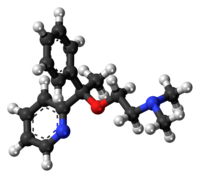User:Mr. Ibrahem/Doxylamine
 | |
 | |
| Clinical data | |
|---|---|
| Trade names | Unisom, Vicks Formula 44 (in combination with Dextromethorphan), others |
| AHFS/Drugs.com | Monograph |
| MedlinePlus | a682537 |
| Pregnancy category |
|
| Routes of administration | By mouth |
| Drug class | First-generation antihistamine[1] |
| Legal status | |
| Legal status | |
| Pharmacokinetic data | |
| Bioavailability | By mouth: 24.7%[2] Intranasal: 70.8%[2] |
| Metabolism | Liver (CYP2D6, CYP1A2, CYP2C9)[3] |
| Elimination half-life | 10–12 hours[3] |
| Excretion | Urine (60%), feces (40%)[4] |
| Identifiers | |
| |
| Chemical and physical data | |
| Formula | C17H22N2O |
| Molar mass | 270.369 g·mol−1 |
| 3D model (JSmol) | |
| |
| |
| (verify) | |
Doxylamine is a first-generation antihistamine used for trouble sleeping and allergies.[1] Use for trouble sleeping should be short term.[1] Onset of effects is about half an hour.[1] It is also used in combination with vitamin B6 (pyridoxine) for nausea and vomiting of pregnancy.[5] It is taken by mouth.[1]
Common side effects include sleepiness.[1] Other side effects include dry mouth, urinary retention, and glaucoma.[1] Children may get restless.[1] Use in pregnancy appears safe.[6] It works by blocking H1 receptors and thus blocking the effects of histamine.[1]
Doxylamine was first described in 1948.[7] It is available as a generic medication.[1] In the United States it costs less than 10 USD for 30 tablets of 25 mg as of 2020.[8]
References[edit]
- ^ a b c d e f g h i j "Doxylamine Succinate Monograph for Professionals". Drugs.com. Retrieved 8 October 2020.
- ^ a b Pelser A, Müller DG, du Plessis J, du Preez JL, Goosen C (2002). "Comparative pharmacokinetics of single doses of doxylamine succinate following intranasal, oral and intravenous administration in rats". Biopharm Drug Dispos. 23 (6): 239–44. doi:10.1002/bdd.314. PMID 12214324. S2CID 32126626.
- ^ a b Meir H. Kryger; Thomas Roth; William C. Dement (1 November 2010). Principles and Practice of Sleep Medicine E-Book. Elsevier Health Sciences. pp. 925–. ISBN 978-1-4377-2773-9.
- ^ "New Zealand Datasheet: Doxylamine Succinate" (PDF). Medsafe, New Zealand Medicines and Medical Devices Safety Authority. 16 July 2008. Archived from the original on 22 March 2016.
- ^ BNF 79 : March 2020. London: Royal Pharmaceutical Society. 2020. p. 442. ISBN 9780857113658.
- ^ Briggs, Gerald G.; Freeman, Roger K.; Yaffe, Sumner J. (2008). Drugs in Pregnancy and Lactation: A Reference Guide to Fetal and Neonatal Risk. Vol. 2. Lippincott Williams & Wilkins. p. 89. doi:10.1258/om.2009.090002. ISBN 978-0-7817-7876-3. PMC 4989726.
{{cite book}}:|journal=ignored (help) - ^ Fischer, Jnos; Ganellin, C. Robin (2006). Analogue-based Drug Discovery. John Wiley & Sons. p. 546. ISBN 9783527607495.
- ^ "Compare Doxylamine Prices". GoodRx. Retrieved 8 October 2020.
